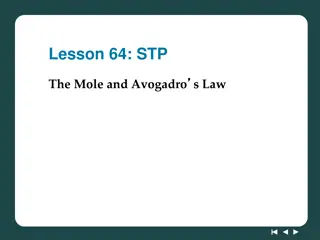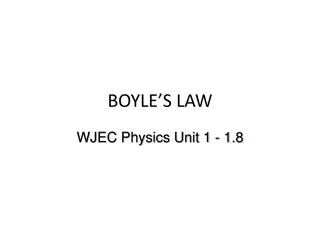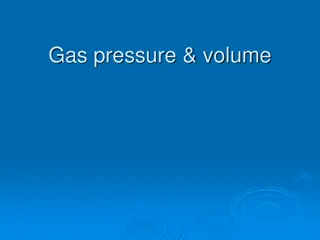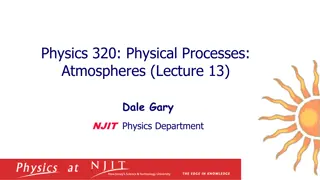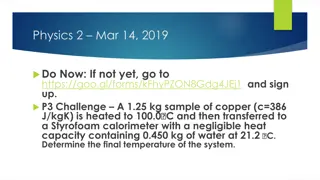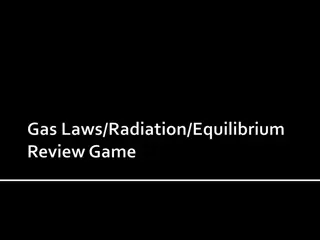Understanding Gas Pressure and Temperature in Physics
Explore the concepts of gas pressure and temperature in this educational material, covering calculations for specific latent heat, explanations on how gases exert pressure on surfaces, and the impact of temperature on gas pressure. Engage with visual aids and tasks to deepen your understanding of gas behavior.
Download Presentation

Please find below an Image/Link to download the presentation.
The content on the website is provided AS IS for your information and personal use only. It may not be sold, licensed, or shared on other websites without obtaining consent from the author. Download presentation by click this link. If you encounter any issues during the download, it is possible that the publisher has removed the file from their server.
E N D
Presentation Transcript
Gas pressure & temperature Do now activity: 1. What is the calculation for specific latent heat of fusion? 2. What is the calculation for the specific latent heat of vaporisation? 3. How does a gas exert pressure onto a surface?
Progress indicators GOOD PROGRESS: - Describe how a gas exerts pressure on a surface - Explain how the pressure of a gas in a sealed container is affected by changing the temperature of the gas OUTSTANDING PROGRESS: - Explain a practical set-up which allows us to visualise gas molecules moving around at random
Think > Pair > Share: How does a gas exert pressure on a surface? Gas particles collide repeatedly with each and the surface inside the container. Each impact on the surface exerts a tiny force, the total force causes a steady pressure on the surface. The pressure of a gas on the surface is the total force exerted on a unit area of the surface.
Task: Watch the video and answer the following questions: https://www.youtube.com/watch?v=hKO3DpgiISk 1. How can you describe the movement of gas particles? 2. How does a gas exert pressure on a surface? 3. How are we able to increase gas pressure 4. Describe the motion of gases at low temperatures 5. Describe the motion of gases at higher temperatures 6. What impact does the temperature have on gas pressure?
Self-assessment: 1. 2. Gas pressure occurs when gas particles collide repeatedly with the walls of the contained that the gas is held in. 3. We can increase gas pressure if we increase the number of collisions per second or the energy of each collision. 4. At low temperature, particles have low kinetic energy and so have fewer collisions per second and these are lower energy collisions. 5. At higher temperatures, particles have more kinetic energy and so have more collisions per second, and these are higher energy collisions. 6. At lower temperatures, the gas pressure is lower, at higher temperatures the gas pressure is higher. Gas particles move in a random motion
Gas pressure & temperature Air is sealed in a flask, which is then placed in a water bath. The water is heated in stages to raise the temperature in stages, the water must be stirred at each stage. Task: Answer the questions on the worksheet.
Self-assessment: 1. It is important to stir the water at each stage to ensure that the water temperature is the same throughout. 2. Temperature is measured with the thermometer 3. Pressure is measured using the pressure gauge. 4. 5. As the temperature increases, the pressure also increases. This is due to the gas particles possessing more kinetic energy, this means they will collide more frequently and more forcefully with each other and the surface of the container. This leads to an increase in pressure. X Pressure (Pa) X XX X X XXXX Temperature ( C)
Observing random motion Task: Read the information on the sheet and answer the following questions: 1. Describe the movement of smoke particles as seen in a smoke cell. 2. Draw and label a diagram to demonstrate this movement of smoke particles. 3. What does the movement of smoke within a smoke cell provide us evidence of? https://www.youtube.com/watch?v=4m5JnJBq2AU
Self-assessment: 1. The smoke particles move randomly throughout the smoke cell, can be called Brownian motion. 2. 3. The random and unpredictable motion of smoke particles in the smoke cell is evidence of the random motion of gas molecules.
Plenary: Complete the following sentences in your books: a) Today I learnt b) I already knew that c) I would like to learn more about
Resources Resources
How does a gas exert pressure on a surface? How does a gas exert pressure on a surface? What impact does the temperature have on What impact does the temperature have on How can you describe the movement of gas How can you describe the movement of gas How are we able to increase gas pressure How are we able to increase gas pressure Describe the motion of gases at higher Describe the motion of gases at higher Describe the motion of gases at low Describe the motion of gases at low gas pressure? temperatures temperatures gas pressure? temperatures temperatures particles? particles? 2. 3. 4. 5. 6. 3. 2. 4. 5. 6. 1. 1.
1. Why is it important to stir the water at each stage of the investigation? Gas pressure & temperature 2. How is the temperature measured? 3. How is the pressure measured? 4. The following results were collected for an unknown gas using the apparatus below, plot the results onto a graph: Temperature ( C) 0 10 20 30 40 50 60 70 80 90 100 Pressure (Pa) 40 45 50 55 60 65 70 75 80 85 90 5. Using the results above, write a conclusion for the investigation which includes an explanation for the effect of an increased temperature on pressure.
Observing random motion Individual molecules are too small for you to see directly, but by using a piece of equipment called a smoke cell and a microscope. The smoke cell is firstly filled with smoke and a light is shone into the cell. You can view the smoke particles using a microscope and what you will observe is the smoke particles constantly changing direction. The path taken by one smoke particle will look something like this Why is this happening? The air particles, which we cannot see, are repeatedly colliding at random with the larger smoke particles. The air particles must be moving very fast as they are much to small for us to observe. What we can see are the smoke particles moving in random directions due to the random impacts of the air particles on each smoke particle.
Pressure gauge Thermometer Dry air Water bath Heater









